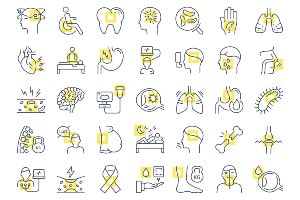About Sexual Response Cycle (Phases of Sexual Response)

Learn about the disease, illness and/or condition Sexual Response Cycle (Phases of Sexual Response) including: symptoms, causes, treatments, contraindications and conditions at ClusterMed.info.
Sexual Response Cycle (Phases of Sexual Response)

| Sexual Response Cycle (Phases of Sexual Response) |
|---|
Sexual Response Cycle (Phases of Sexual Response) InformationIntroduction to the sexual response cycleThe sexual response cycle refers to the sequence of physical and emotional changes that occur as a person becomes sexually aroused and participates in sexually stimulating activities, including intercourse and masturbation. Knowing how your body responds during each phase of the cycle can enhance your relationship and help you pinpoint the cause of any sexual problems. Phase 1: ExcitementGeneral characteristics of the excitement phase, which can last from a few minutes to several hours, include the following:
Phase 2: PlateauGeneral characteristics of the plateau phase, which extends to the brink of orgasm, include the following:
Phase 3: OrgasmThe orgasm is the climax of the sexual response cycle. It is the shortest of the phases and generally lasts only a few seconds. General characteristics of this phase include the following:
Phase 4: ResolutionDuring resolution, the body slowly returns to its normal level of functioning, and swelled and erect body parts return to their previous size and color. This phase is marked by a general sense of well-being, enhanced intimacy and, often, fatigue. Some women are capable of a rapid return to the orgasm phase with further sexual stimulation and may experience multiple orgasms. Men need recovery time after orgasm, called a refractory period, during which they cannot reach orgasm again. The duration of the refractory period varies among men and usually lengthens with advancing age.SOURCE:Discovery Health.Reviewed by Robert S. Phillips, MD on July 08, 2008Portions of this page © Cleveland Clinic 2008 What Are the Phases of the Sexual Response Cycle?Sexual Response CycleThe sexual response cycle has four phases: excitement, plateau, orgasm, and resolution. Both men and women experience these phases, although the timing usually is different. For example, it is unlikely that both partners will reach orgasm at the same time. In addition, the intensity of the response and the time spent in each phase varies from person to person. Understanding these differences may help partners better understand one another's bodies and responses, and enhance the sexual experience. |
More Diseases
A | B | C | D | E | F | G | H | I | J | K | L | M | N | O | P | Q | R | S | T | U | V | W | X | Y | Z
Diseases & Illnesses Definitions Of The Day
- Coughs (Chronic Cough) ‐
- Paget's Disease of The Nipple ‐ How is Paget disease of the breast diagnosed?, How is Paget disease of the breast treated? …
- Acquired Bronchiectasis (Bronchiectasis (Acquired, Congenital)) ‐ Can bronchiectasis be prevented?, How is the diagnosis of bronchiectasis made? …
- Celiac Disease (Gluten Enteropathy) ‐ Are there other diseases or conditions associated with celiac disease? …
- Pinky, Broken Finger (Broken Finger) ‐ Broken finger facts, Broken finger introduction, How can a broken finger be prevented? …
- Poison Ivy, Oak, and Sumac ‐ Are there any home remedies for a poison ivy, oak, or sumac rash? …
- Abuse, Steroid (Anabolic Steroid Abuse) ‐ Anabolic steroid abuse facts, Are anabolic steroids addictive? What are the symptoms and signs of anabolic steroid abuse? …
- Preeclampsia (Pregnancy Induced Hypertension) ‐ Does Hypertension or Preeclampsia During Pregnancy Cause Long-Term Heart and Blood Vessel Problems? …
- Trench Foot (Frostbite) ‐ Chilblains signs and symptoms, First aid treatment for frostbite …
- Brain Aneurysm ‐ Brain aneurysm facts, How is brain aneurysm diagnosed?, What are future directions for the treatment of brain aneurysm? …